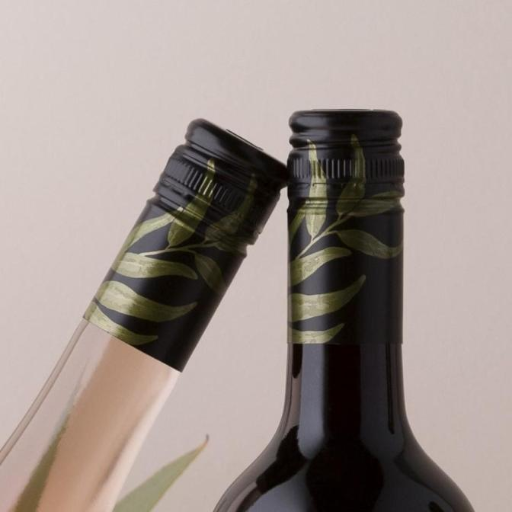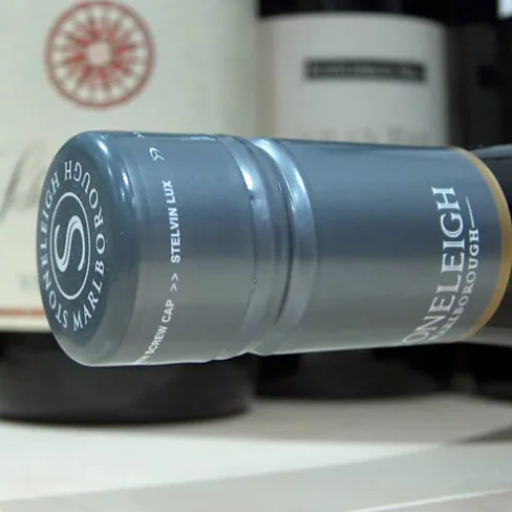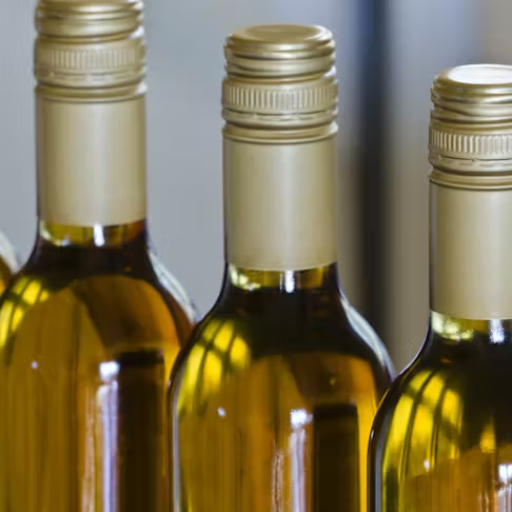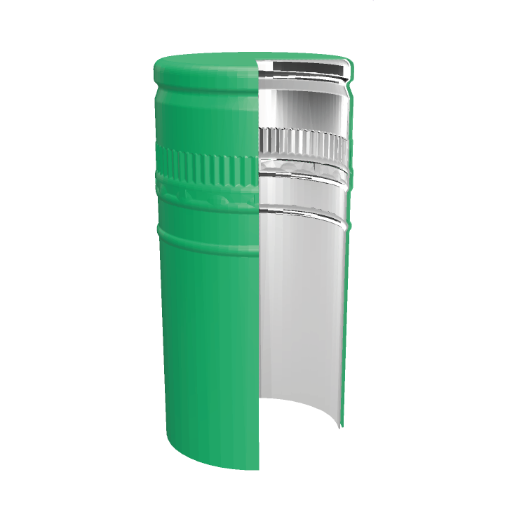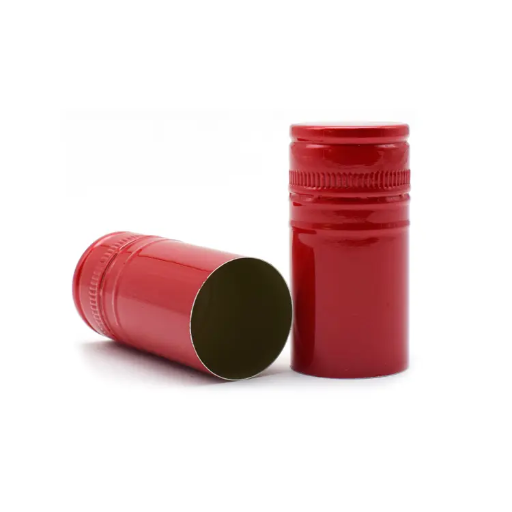Let us now take a look at Stelvin® Closures, an innovation in wine conservation. Boosting the quality and science behind Stelvin® Closures is the purpose of this blog, as these have changed the way we keep and appreciate wine. By recognizing how the designs function, one may similarly know why they are better than cork when it comes to maintaining wine’s originality and consistency. Learn about Stelvin® Closures’ history, mechanisms and unmatched benefits of these closures that has made them popular among winemakers and wine lovers alike. With this information you will understand how Stelvin® Closures are changing wine preservation forever so that every gulp remains as pleasant as it should be.
The Rise of Stelvin® Screw Cap in the Wine Industry
How Stelvin® Closure Changed Wine Storage and Quality
Stelvin® screw caps have had a profound impact on wine industry, which I have been privileged to witness as an industry expert. Traditionally, people used natural corks for sealing wine bottles although they had some challenges like a musty smell and inconsistencies in the aging process. However, the introduction of Stelvin® closures brought an enormous difference in these issues. By providing a more reliable and consistent seal, Stelvin® screw caps changed the way wine is stored and improved its quality. This enables the protection of wines from oxidation that could end up changing their taste over time thereby maintaining their intended flavor profile throughout their storage life span. Together with other benefits such as ease of opening and reclosing, Stelvin closures have found wide acceptance within the winemakers’ community as well as consumers.
The Battle Against Cork Taint: Stelvin® vs. Natural Cork
In my experience working in this field I’ve seen how cork taint can turn off many customers who are usually looking for only one thing: a good bottle of wine gone bad through no fault of its maker or vendor. Although traditional and attractive natural corks are vulnerable to being contaminated by TCA (trichloroanisole). It alters the flavors and odors of wines making them undrinkable due to having strange chemicals found in them such as TCA that leaves undesirable tastes and smells referred to moldy odor syndrome on wines. On the contrary, Stelvin® closures provide an ultimate answer to this problem at hand . These aluminum made screw tops with inert lining completely eradicate chances of occurrence TCA inside these stoppers, thus guaranteeing that true nature of wine is maintained besides giving consumers consistency anytime they purchase it. Nothing can replace peace of mind offered by cork taint-free bottle hence why Stelvin® provides better solution against this ancient challenge.
The Engineering Behind Stelvin® Screw Caps: Seals and Liners
It is worth noting that the engineering precision behind Stelvin® screw caps is simply amazing. They are fitted with an airtight barrier of high-performance seal and liner system at their core. Firstly, these caps are made out of aluminum of the highest quality making them durable as well as fitting to the neck of the bottle perfectly. The liners within the Stelvin® caps have been made with inert materials to prevent any reaction with wine thus protecting its flavor integrity while in store. Once sealed, they form a hermetic closure effectively keeping out oxygen and avoiding contamination. As an industry expert, I have found that the combination of these advanced seals and liners is key to maintaining the wine’s quality over extended periods. Consequently, one can be assured that every time they enjoy their favorite drink, it will be consistent, dependable and top-notch quality.
Comparing Stelvin® Closure System with Traditional Cork
The Aroma and Freshness Preservation Battle: Screw Cap vs. Cork
I am an industry player who has spent many years examining different wine enclosures and I have first-hand witnessed screw caps especially Stelvin® closures outperforming the traditional corks in maintaining the aroma and freshness of wines. However, traditional corks, which are iconic in the wine industry, are highly susceptible to TCA contamination that can severely reduce the aroma and liveliness of wine. Conversely, Stelvin® screw caps offer hermetic seals that do not allow oxygen to come into contact with wine hence keeping it fresh all through. The airtight barrier is very critical when it comes to holding back the intended flavour profile of a particular wine as well as its aromatic intensity even over long periods. In my opinion, wines sealed with Stelvin® caps constantly deliver fresh unadulterated experiences that surpass occasional surprises of cork sealed bottles. This invention has not only instilled confidence among consumers but also helps vintners present their wines untouched bottle after bottle.
Oxidation and Wine Faults: Does Stelvin® Offer Superior Protection?
One of the major agents responsible for wine faults is oxidation which result in undesirable changes in taste, scent or color. Traditional corks provide some protection against oxidation; however they might let minute amounts of air get inside overtime leading to oxidative spoilage. These tightly-fitting engineered lids save a great deal as far as oxidation is concerned unlike other materials used for closure such as traditional corks. Thus, by using this type of screw cap, no matter how much air might be squeezed in at time zero through bottling to consumption stages will remain intact because it’s sealed from outside air completely making sure there is no oxygen within within bottle space. In my perspective, most consumer packaged wines under such covers show an amazing resistance towards common faults including browning, premature aging or even oxidations. Not only does it extend shelf life but also every bottle opens up with freshly plucked vibrancy, just like the one intended by the producer.
Public Perception: Embracing Stelvin® over Natural Cork
I have observed a great change in public opinion where more people prefer using Stelvin® closures to natural corks and I have also seen this happening. The screw caps were initially not welcomed but the situation is now different whereby consumers as well as wine experts themselves have recognized their value. This movement has been made possible because of the high quality of Stelvin® closures that are always reliable. Wine enthusiasts love being able to unseal with ease, guaranteeing zero defects within. What’s more, it eliminates cork taint that often occurs when wine is sealed with natural cork; therefore making a stronger case for the use of Stelvin® closures instead. Even vintners are increasingly realizing that these stoppers preserve the winemakers’ intention character and age ability than any other kind used for closure on their wines. On one hand, innovation and tradition conscious industry has witnessed Stelvin® caps stand out as an alternative to be adopted at present.
Stelvin® Lux: Blending Aesthetics and Functionality in Wine Bottling
Stelvin® Lux – Posing as a Traditional Wine Capsule with Contemporary Advantages
Being an industry expert, I have witnessed how amazing Stelvin® Lux closures can be. These new type of closures combine the look of traditional wine capsules together with the modern Stelvin technology. In my opinion, this bottle show off what makes them so great; they provide a good looking aesthetic design reminiscent of traditional wine bottles while guaranteeing that the wine inside is fully protected. The well-reasoned fasteners lock in flavor, smell and freshness without any inconsistency whatsoever. One feature that distinguishes the Lux series from its predecessors is its air tightness that keeps out various types of faults such as cork taint or oxidation which are characteristic to other wines. This merging of old and new concepts provides a refined answer for both traditionalists and contemporaries among oenophiles.
Innovation in Seal Technology: The Role of Liners in Stelvin® Lux
As an industry insider, I would like to enlighten you on how important liners are in the effectiveness of Stelvin® Lux closures. These closures consist of liners that have been designed with a lot of detail to ensure they give wine the highest form of protection by addressing several parameters. Let’s dissect them one after another.
- Oxygen Transmission Rate (OTR): The liner is responsible for allowing some oxygen into the bottle of wine which is crucial in preserving its taste and aroma. Low OTR levels prevent oxidation thus maintaining the intended wine profile as time passes by.
- Elasticity and Flexibility: This liner material must be elastic and flexible enough so that it can fit perfectly on the lip around bottle’s mouth. Such ability helps to keep air tightness that is critical for wine preservation.
- Chemical Resistance: The liner chosen should not react chemically with the wine, thus preventing any unwanted tastes or spoilage resulting from interaction between closure material and wine.
- Moisture Resistance: Keeping off moisture is very key in ensuring that your bottle of wine does not develop faults. Liners are made not to allow water including fermentation problems and other issues connected with moisture in.
- Durability: They also need to be durable enough for long term storage conditions meaning that there must be no leakage from sealing point till finally it gets opened by a consumer
Stelvin® Lux liners have engineered these factors so carefully that they save your wines from external forces capable of compromising their quality. It paves way for this innovation in seal technology which allows winemakers with confidence use these closures knowing their wines will get to consumers at best possible condition.
Winery Adoption: The Growing Use of Stelvin® Lux by the Top Brands
As an industry expert, it is apparent that wineries that are leading in the market have chosen to use Stelvin ®Lux because of a combination of quality control and consumer satisfaction. Wineries are now realizing that closures should be used which not only seal their bottles tight but also improve the general appearance of the product. There fore, these needs are met by Stelvin® Lux range with its advanced technology that guarantees optimal oxygen transition rates, flexible elasticity, and strong chemical resistance. Moreover, its design is attractive and suitable for any luxurious brand. Switching to Stelvin® Lux allows vintners to protect their wines effectively while satisfying the aesthetic tastes that discerning wine connoisseurs from all over the world expect from them.
The Environmental Impact of Switching to Stelvin® Screw Caps
Aluminium vs. Cork: Assessing the Sustainability of Wine Closures
When considering the sustainability of wine closures, both cork and aluminum have unique advantages and factors to be considered. To explain further, here is a list of some relevant parameters that can be used as a basis for comparison:
Availability and Renewable Resources:
- Cork: Cork is harvested from the bark of cork oak trees that grow back after being stripped off their barks. This cycle makes it possible that every harvest can be repeated without cutting down the trees.
- Aluminium: Aluminum is produced from bauxite ore through an energy consuming process. Though abundant, its extraction and refining processes have enormous environmental impacts. However recycling it has high returnability to offset some these.
Carbon Footprint:
- Cork: The production of cork closures has low carbon footprint because it only involves minimal processing. Also, Cork oak forests act as huge carbon sinks which remove CO2 from air.
- Aluminium: Initial aluminium production results in a large amount of carbon dioxide due to its mining and processing energy requirements. On the contrary, recycling aluminium needs very little energy compared with producing new aluminium which significantly reduces its carbon footprint.
Ecosystem Impact:
- Cork: These forests support diverse plants and animals hence they are biodiversity hotspots. Sustainable harvesting of cork can help preserve such ecosystems while supporting biodiversity.
- Aluminium: Mining for bauxite ore may cause deforestation, pollution of water sources, or habitat loss. Reduced ecosystem impairment necessitates responsible mining practices including land reclamation efforts.
Recycling:
- Cork: Natural corks degrade and are recyclable even though natural cork’s recycle ability is less common in all areas.
- Aluminium: Aluminium ranks among the world’s most recycled materials; it can constantly be melted for rebirth without losing quality making it highly sustainable.
Consumer Perception and Performance:
- Cork: Some wine lovers still prefer corks for their traditional appeal associated with luxury wines. However there is risk of tainting wine by use of food stoppers made from cork.
- Aluminium: The Stelvin® Lux screw caps made from aluminium offer a strong seal capable of protecting the wine’s quality and maintaining its performance. Consequently, these are convenient for buyers and go together with modern, sleek packaging designs.
In conclusion, both aluminum and cork as wine bottle closures have their pros and cons. This knowledge enables vintners and purchasers to make prudent choices that correspond to their eco-friendly targets plus taste preferences.
Stelvin® closures: Recycling Challenges and Opportunities
Because these are mainly made from aluminum, Stelvin® closures represent unique recycling challenges and opportunities. The segregation of materials is one big problem; Stelvin® caps often contain traces of other plastics and impurities that require careful sorting before they can be recycled. But aluminium’s high recycling rate poses an outstanding opportunity despite the fact. Aluminum can be recycled over and over again without losing its properties thereby reducing the impact on the atmosphere significantly. Wineries could enhance their rates of reusing Stelvin ® closures if they could just collect them effectively as well as sort them properly in order to contribute towards circular economy principles while at the same time reinforcing their commitment to sustainability. Furthermore, collective industry effort along with consumer education can assist in obtaining better results from recycling, leading to more reclaimed and repurposed closures.
Reducing Wine Bottle Variation and Contamination Through Innovative Sealing
Sealing is crucial for wine experts because it helps reduce variations in wine bottles and possible contamination. Modern sealing techniques like using Stelvin® closures ensure airtight seals that prevent oxidation as well as contamination by foreign materials. This hermetic closure thus protects the wine during its entire journey from production up to consumption so that every bottle tastes exactly the same according to those who created it . Another benefit of these advances is mitigating risks associated with cork taint or differences expected due to traditional corks . Product consistency would be increased through high quality innovative sealing solutions which will meet consumers’ expectations while still adhering to strict quality standards along the supply chain within wineries
How Winemakers Choose Between Stelvin®, Cork, and Other Closure Systems
Considering Wine Style and Maturation: Selecting the Right Closure
As an authority in the industry, I would like to point out that choosing the right wine bottle closure is mainly influenced by elements such as wine style, maturation prospects and customer tastes. Allow me to break it down:
- Wine Style: Different kinds of wines call for different closures. For instance, Stelvin® closures are good for screw caps on young and fresh wines because they help preserve their crispness and fruity characteristics while preventing oxidation. However, some luxury red wines with complex structures may benefit from natural cork closures that permit little oxygen passage into the bottles contributing to subtle desirable aging.
- Maturation Potential: Wines intended for aging in bottles may require slow oxygen exchange supporting seals. Natural cork closings are often preferred over others since they allow small quantities of air into contact with wine over long periods which therefore contribute to its complexity and depth. In contrast, if you are making a wine meant to last only a few years, then Stelvin® closures will be good idea because they eliminate any exposure to oxygen.
- Consumer Preferences: The choice of target audience matters too. Some people link traditionalism and quality with natural corks as the preferred sealing method for their wines. Others however prefer Stelvin® closures because of their ease when using them as well as their convenience; especially when placed in casual or on-the-go settings.
- Risk of Contamination: Wine can spoil due to TCA (trichloroanisole), This gives rise to a condition called “cork taint” that can spoil wine leading customers dissatisfaction with the product purchased. On the other hand, brands that want consistency and reliability should go for Stelvin® closures since they do not present this danger.
- Environmental Impact: Environmental sustainability is gaining more consideration now than ever before. Even though both cork stoppers and Stelvin® caps have their ecological footprints, it should be noted that cork is a renewable resource. Nonetheless, Stelvin® closures are recyclable and efficient recycling programs would go a long way in reducing their environmental impact.
Considering these parameters allows winemakers to choose the closure that best suits their wine’s style, intended maturation period, customer expectations as well as sustainability targets. This kind of conscious selection ensures that each bottle is delivered to the consumer with the right quality and taste it should have.
Stelvin® Wine Screw Caps Consumer Trends and Market Acceptance
From my standpoint as an industry expert, Stelvin® wine screw caps has been interesting and transformative. In recent times, there has been a noticeable drift among customers especially the young people who are choosing screw caps because of their convenience and modernity. This shift is mainly due to lifestyle changes, with most consumers preferring wines that are easy to open and reseal for casual or even spontaneous reasons.
There is also an increasing recognition of how Stelvin® closures can help in preserving quality. Both connoisseurs and everyday drinkers have started realizing the benefits of consistency and reliability associated with screw caps that prevent cork taint while sustaining the intended flavor profile for each bottle. This confidence in staple is even more attractive during this period when brand reputation and consumer trust are highly valued.
The aspect of environmental consciousness cannot be overlooked. The recyclable nature of Stelvin closures goes hand-in-hand with the eco-friendly values that modern day consumers believe in today as more people become more sustainable conscious. Although traditional cork still maintains some attraction due to its tradition and romance appeal but obviously practical considerations as well as changing perceptions have led to considerable acceptance of screw cap by market players. Rather than just being a fleeting phase, this trend suggests a wider paradigm shift within the wine industry regarding packaging and satisfaction of customers.
Closure Choice Impact on Wine’s Market Position and Brand Perception
While historical preferences have often favoured traditional cork, adopting screw caps will greatly enhance a wine’s market position and brand perception. Several practical advantages make screw caps suitable for modern consumers such as convenience, quality consistency, or sustainability among others. From a market perspective, wines sealed with screw caps make them appealing to wider audiences particularly younger consumers who emphasize ease-of-use without compromising taste at all costs. Furthermore, environmentally aware buyers are likely to develop more trust and loyalty towards brands that adopt screw caps. Hence, screw cap is not just a functional move; it is rather a strategic decision that can strengthen the company’s presence in the market and further make it conform with consumer expectations of these days.
Reference sources
1. Online Article: “Stelvin® Closures: Changing the Wine Industry Landscape” – Wine Enthusiast
- Source: Wine Enthusiast
- Summary/Annotation: This article from Wine Enthusiast provides an in-depth overview of Stelvin® closures, discussing their impact on the wine industry and how they revolutionize wine preservation. It explores the history of Stelvin® closures, their design features, and the benefits they offer over traditional cork closures, such as consistency in sealing, prevention of cork taint, and ease of opening. The article also highlights consumer and industry perspectives on the transition from cork to screw caps and includes interviews with winemakers who have adopted Stelvin® closures. Wine Enthusiast is a reputable publication in the wine industry, ensuring the content is accurate and insightful. This source is valuable for readers seeking a comprehensive understanding of how Stelvin® closures are transforming wine packaging and preservation.
2. Academic Journal: “Assessing the Impact of Stelvin® Closures on Wine Quality and Aging” – American Journal of Enology and Viticulture
- Source: American Journal of Enology and Viticulture
- Summary/Annotation: This peer-reviewed paper published in the American Journal of Enology and Viticulture examines the impact of Stelvin® closures on wine quality and aging. The study includes experimental data comparing wines sealed with Stelvin® closures and traditional corks over different aging periods. It evaluates parameters such as oxygen ingress, flavor profile stability, and chemical composition changes. The research aims to provide scientific evidence on the effectiveness of Stelvin® closures in preserving wine quality over time. As an academic journal, this source offers high credibility and technical depth, making it essential for readers interested in a rigorous scientific understanding of the benefits and potential limitations of Stelvin® closures for wine preservation.
3. Manufacturer Website: “Stelvin® Closures: Innovation in Wine Sealing Technology” – Amcor
- Source: Amcor
- Summary/Annotation: Amcor’s website provides detailed information about Stelvin® closures, including their design, technical specifications, and advantages. The site features descriptions of various Stelvin® closure models, their application in different types of wines, and customizable options for branding and aesthetics. It also offers insights into the technology behind Stelvin® closures, such as advanced sealing mechanisms and oxygen control. Amcor is the manufacturer of Stelvin® closures, ensuring authoritative and practical insights. This source is crucial for professionals and winemakers seeking reliable information on the technological innovations and benefits of using Stelvin® closures for wine preservation.
Frequently Asked Questions (FAQs)
Q: What is a stelvin closure?
A: A wine bottle screw cap, which is more popularly referred to as a Stelvin closure, is an aluminum closure for wine bottles. It provides an alternative to cork closures offering better conformities that prevent the spoiling of wines with oxidation and cork taint (TCA). Amcor developed it and has now found wide acceptance among wine producers, especially in Australia and New Zealand.
Q: How does the stelvin closure system work?
A: In order to make this happen, this system uses a cover that screws onto threads at the top of a wine bottle. This mechanism contains a special liner typically made from polyvinylidene chloride (PVDC), which acts as phenomenal oxygen barrier hence keeping the oxidation rate low and ensuring no chances of TCA. The simple functioning of the stelvin closure makes it easier to open compared to conventional corks.
Q: What are the benefits of using stelvin closures over traditional cork closures?
A: These include reduced susceptibility to oxidization or getting affected by cork taints like TCA. Stelvin closures provide tighter seals that greatly lower risks associated with oxidation and Cork taint-TCA thus improving uniformity in wines quality. Moreover, these caps are easier to remove unlike corks thus eliminating need for pulling out corkscrew while opening bottles. They are also less variable than corks making them more reliable in sealing conditions. In the case of saving white wines’ particular characters and subtle varietals predictability helps.
Q: Are stelvin closures only suitable for certain types of wine?
A: Initially they were used widely on whites because they held fruitiness; however today they can be seen on both reds and whites. Their ability to hold onto flavor profiles as intended without faulting such as oxidation makes them able to be used across many different types including fine examples from places like Burgundy. Winemakers around the world have highly embraced stelvin closures.
Q: Can stelvin closures affect the aging process of wine?
A: Aging under stelvin closures can be different from corks as a result of reduced ingress of oxygen, which is an important aspect in aging. Stelvin closures give a tighter seal that slows down oxidation and may influence the course of wine aging. According to some research studies and winemakers’ experiences, wines aged under these aluminum screw caps are able to retain their freshness and fruitiness for longer periods; however, more conclusive results need to be supported by further research on complex interactions associated with wine aging.
Q: Are stelvin closures environmentally friendly?
A: Stelvin closures, which are predominantly made from aluminum, are considered green due to 100% recyclability of aluminum. The manufacturing process for aluminium screw caps is energy intensive but this is compensated for by the fact that it can be recycled several times without quality degradation across its lifecycle. Companies like Amcor and Orora Beverage have played significant roles in making the manufacturing process as eco-friendly as possible contributing to the increasing popularity of stelvin closure as an option favorable among vintners caring about environmental sustainability.
Q: What innovations have been made in the design of stelvin closures?
A: Recent developments in designing stelvin closures aim at improving both sealing efficiency and appearance. For example, Stelvin Lux is one type of other stellin closures that imitates traditional cork look with sleeker design aiming at aluminium screw cap technical benefits. Furthermore, advancements in liner technologies have increased its ability to control oxygen transmission rates thus keeping wines fresh and robust.
Q: How has the perception of stelvin closures changed in the wine industry?
A: The perception towards the use of stelvin closures has greatly changed over time since they were first introduced by inventors. During their introduction period many people doubted them especially those who specialize in traditional way of making wine, but these closures have been embraced by the wine makers as they have demonstrated ability to maintain the quality of wines and eliminate the problems linked to corks. In fact, the increase in preference for stelvin closures in places like Australia, New Zealand and even Burgundy are clear signs that things have changed. This is a reflection of wine industry’s adaptability and its emphasis on quality and innovation.


